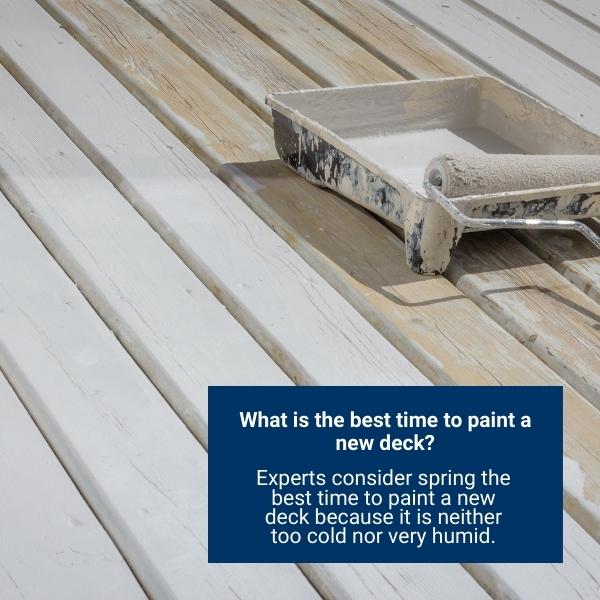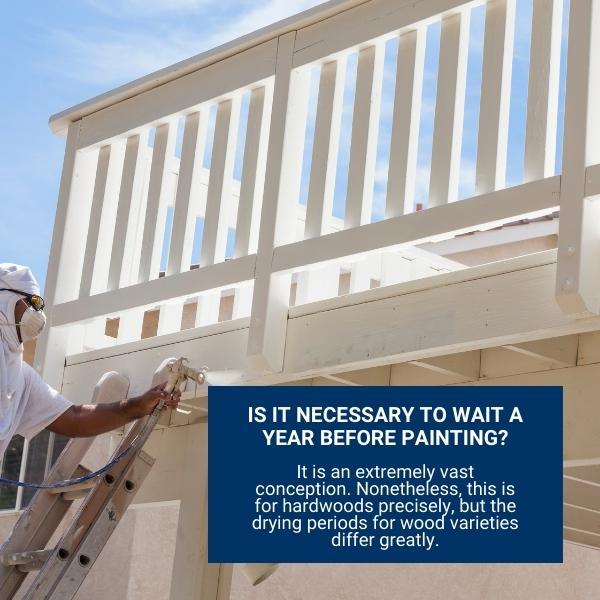Are you desperate to stain or color your wooden deck instantly after fixing up a new deck? You have newly assembled your new patio and would like to color, stain, or close the railings and deck boards. However, you may be confused. How much should you postpone the paint job?
Directly after construction is frequently not the favorable period for coloring decks. When handling a newly constructed deck, it is adequate to pause for a year. It is necessary before coating or staining to assure the stain or color is coated correctly, and the quality of the timber is not risked. Therefore, few people say to wait at least 10 months while some suggest six months.
There is no abrupt and simple explanation for this waiting period. The materials and chemicals that produce pressure-treated lumber protect the wood against rot and insects. Still, it leaves it too saturated to paint immediately. However, an early paint job will result in peeling paint as the chemicals slowly leach out of the wood. It would be helpful if you had a guide to know whether your deck is ready to paint. So, for accurate details, keep reading the article!

Why You Need To Wait Before Painting Your Fresh Deck:
Wood requires a certain period to dry before you can paint it completely. So it is crucial to postpone your finishing touches before painting or staining. According to professionals, the drying time can differ. Therefore there is no easy explanation for how much of an extended time one should wait before staining or painting a patio.
Chemicals Of The Wood:
Wood needs a fixed time to dry out. It is because of the elements and chemicals utilized to make it. Professionals state that the quantity of these elements and chemicals used dictates the drying duration the lumber needs. Temperature and the time the wood has been kept in the wood manufacturing space can also impact the drying duration.
Also Read: Deck vs Interlock: Which One To Use And Where?
Properties Of The Wood That Suggest Delay Painting:
Whenever we purchase wood for decking, some chemicals are already in the wood to protect it from pests and rot. Nonetheless, they make the wood too moistened to grip any stain or paint. If the wood is colored before it has sufficient time to dry up, the stain and color will scrape off and peel as the different chemicals then leach out of the timber.
Using the timber imprinted with a sign that says KDAT (kiln-dried after treatment) lessens the time to wait before painting it substantially, but it is more costly.

What Are The Steps Necessary Before Painting Your New Deck?
Before staining, painting, or finalizing your patio’s elements, you will have to wash the deck using a method known as a power wash. You can wash the patio with a mixture of bleach and then rinse it. Subsequently, allotting sufficient deck time to dry out, your deck should be ready to move on to the next step!
What Do I Usually Use To Verify My Wood’s Condition?
I used a precipitation meter to assess the moisture quantity of the wood. If this reading from the moisture meter is smaller than fifteen percent, it can normally be colored. An additional less scientific technique is to drizzle some liquid on the lumber. If it forms beads on the wood’s surface. If it is quickly soaked up into the timber, consider being able to cover the surface with paint.
Is It Necessary To Wait A Year Before Painting?
It is an extremely vast conception.
Nonetheless, this is for hardwoods precisely, but the drying periods for wood varieties differ greatly due to the discrepancies in their layout and consistency. And regardless, that is associated with the wood drying up from freshly cut barks.
Also Read: Deck VS Curb Mounted Skylight: Differences, Costs, Pros And Cons
Different Properties Of Different Wood:
With your patio’s wood, whatever material you choose, let’s presume it was kiln-dried lumber that became damp due to insufficient and unsuitable warehouse situations. So even if the water volume of the lumber was the same as fresh wood, this is quite distinct as the water is reserved in the wood’s arrangement distinctively.

As an outcome, there is no justification to presume that your lumber would not reach a reasonable water percentage. However, only fourteen to eighteen percent is a far lower value than the expected range, even if kept under decent ventilation and arid, sunny temperature.
Ideal Time To Wait Before Finalizing The Paint:
If the climate where you are appears set to keep up a reasonable time, it will not hurt to pause a little bit longer, but thirty days of drying in favorable circumstances can be enough. Pressure-treated lumber should wait a year to dry before you finalize it. The year will not bother the lumber in the climate at all. Do you require a complete year? Not necessarily, but you will not have sufficient duration to continue allowing it to dry this fall as it can get colder to apply the seal and finalize it.
Also Read: Can You Install Trex Decking In The Winter? A Definitive Guide!
FAQs
Why Is Wood Pressure-Treated?
The color of the wood will pertain more smoothly if the timber is thoroughly dry. The pressure treatment is performed to encourage it to last the weather conditions, and the only justification you will require to do any work this autumn is merely for aesthetics.
What Is The Benefit Of Waiting A Certain Period?
A simple answer to this is my personal experience. I waited enough time and even sought a professional’s help before I went on to paint and thus finalize my patio. It is always better to wait a sufficient time rather than rushing in and ruining your task.
What Should I Do If My Wood Appears Grey Because Of Waiting Too Long?
A light wash can easily renew the look of your wood. And thus, you will not have to worry about the wood’s appearance getting all grey. After that light wash dries up, test it using the above methods, and you should be ready to paint it!

